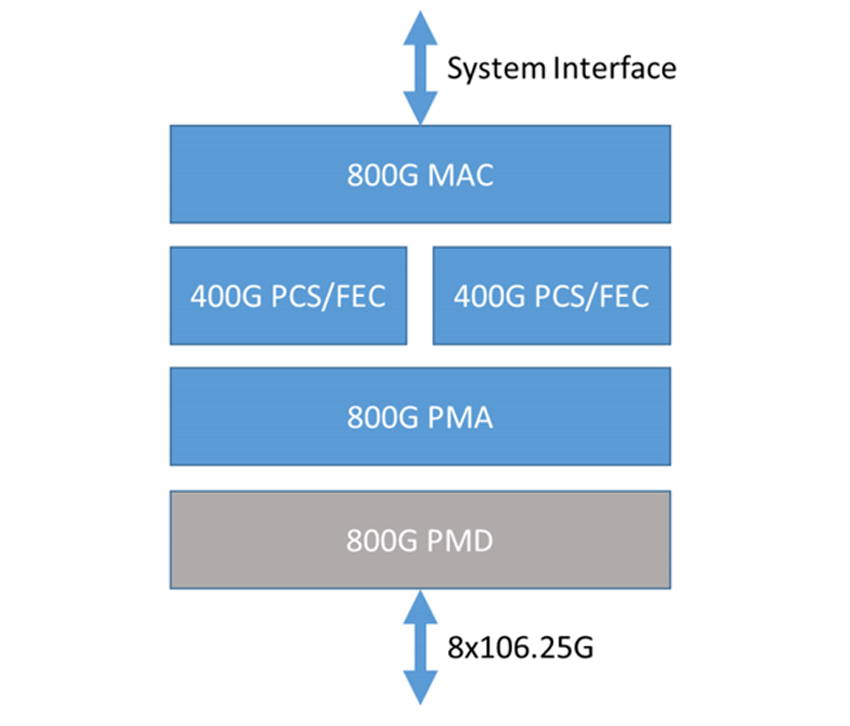
With the introduction of 400G optical modules, the interconnection of data centers is also gradually developing towards 800G Ethernet. The recent OFC 2020 conference in San Diego focused on 800G Ethernet, 800G technology and fiber jumpers for 800G networks, making 800G Ethernet another hot spot after 400G networks. However, 800G Ethernet is still being tested and perfected, and its large-scale deployment is still a long way off.
800G Ethernet and Optical module standard
Compared with 200G and 400G Ethernet, 800G Ethernet is a brand new technology. At present, several working groups have proposed specifications for 800G Ethernet. These specifications will be described in detail below.
1. The 800GBase-R will revert to 400G Ethernet technology for maximum cost savings
Currently, the IEEE (Institute of Electrical and Electronics Engineers) does not have a standard for 800G Ethernet, but the 25G Ethernet Alliance (now known as the Ethernet Technology Alliance (ETC)) established the 800GBase-R specification for 800G Ethernet in April 2020. ETC claims that the specification USES the 400GbE standard to create an 800GbE MAC (media access control) and PCS (physical coding sub layer) specification as much as possible, and reduces the cost that users can achieve multiple rates on Ethernet ports. The 800GBase-R specification still USES the existing 106.25g channels in

2. 800G Pluggable MSA organization defines the application scenario of 800G-SR8 and FR4 light modules
The 800Gbase-R specification defines the base layer of an 800G network, which is expected to double performance again to meet data center requirements. In addition to the base layer of the network, the 800G Pluggable MSA team released the 800Gbps Ethernet transmission specification for data center applications based on Pam-4 modulation technology in September 2019.
l 800G SR8: A cost-effective 8×100G module suitable for short-distance transmission applications, and can transmit 60-100 meters on single-mode fiber.
l 800G FR4: 4x200G optical module, which needs to support new FEC functions.
In addition, it is possible to use pluggable light modules as well as QSFP112-DD and OSFP32 package types, and it is believed that pluggable light modules are still the ideal choice for 800G data centers and operators.
3. The QSFP-DD800 MSA working group developed the hardware specification for the800G optical module
The OPTICAL module MSA working group, composed of Cisco, Broadcom, Juniper, Intel, etc., also believes that pluggable optical modules are the ideal choice for data center interconnection. The working group recently developed the first 800G QDFP dual-density pluggable light module standard, defining the size of the 800G light module, QFPP-DD800. It is reported that this optical module can support 8 high-speed channels, each channel‘s rate is 100G/s, and can be compatible with OPTICAL modules such as QSFP-DD, QSFP+, QSFP28, QSFP56, etc. providing great convenience and advantages for network operators in 800G Ethernet deployment.
Development status of 800G light module and technology
Although specifications for 800G Ethernet and optical modules have been developed, they will likely need to be modified or refined in the future based on actual applications (this situation will not affect the high-speed development of optical modules in data center interconnection). Another factor contributing to the bandwidth revolution is the emergence of a large number of low-cost optical cables. When the network speed reaches over 800Gbps, the pluggable optical devices will have problems such as insufficient density and power overload. When this happens, technologies such as co-encapsulated optical elements (CPO) may be required to solve such problems.
But at present, the network needs to develop towards higher speed and maintain higher performance, which is no doubt not a great challenge for optical devices. At the same time, due to the complex structure, 800G pluggable light module will not be quickly produced and put into use on the "customer side". The 800G Pluggable MSA team announced that they have been making 800G light module samples, and the first batch of light module samples are expected to be completed in 2021. Inphi recently announced that it is sampling the new Spica 800G 7nm PAM4 DSP, which it claims is the industry‘s first 800Gbit/s (or 8x100Gbit/s) PAM4 DSP, enabling 800G optical modules to support either qFP-DD800 or OSFP package sizes.
However, for "line side" of the 800 g, 800 g optical device for famous brands is not a new network operators, and its main function is in the "card" (complicated electronic circuit boards, optical communication vendors can develop their own online card network solutions, and other manufacturers of line card no compatibility and interoperability) on the implementation.
How long until the 800G light module arrives?
The continuous growth of cloud computing and data center traffic and bandwidth not only brings huge demand for 800G optical module, but also puts forward higher requirements for switching capacity of switches and routers. With the 400GbE generation ready to launch on the market, the 800G pluggable module is ready. This new ecosystem will be leveraged to provide higher density and cost optimized single-channel 100G and single-channel 200G interconnects for the next generation 25.6T and 51.2T switches.